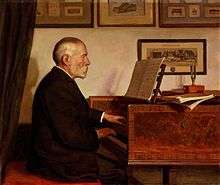Alfred James Hipkins
Alfred James Hipkins FSA (17 June 1826, Westminster – 3 June 1903, Kensington) was an English musician, musicologist and musical antiquary.[1]
In 1840 Hipkins became an apprentice in the pianoforte factory of John Broadwood & Sons Ltd[1][2] and he remained an employee of this company for the rest of his life. Despite having very limited musical training on the pianoforte and the organ, he gained a reputation for his performances of Chopin's music.[1] He wrote many reviews of books on musical ethnology or musical antiquity for The Athenæum and The Musical Times.[3] In 1891 he gave the Cantor lectures on Musical instruments, their construction and capabilities to the Royal Society of Arts.[4]

His chief energies were devoted to a study of the science of music and of the history and quality of keyboard instruments. On the latter subject he became an unrivalled authority. He reintroduced equal temperament in tuning into this country in 1846, and wrote profusely on musical history, contributing largely to 'Grove's Dictionary',[5] as well as to the ninth edition of the 'Encyclopædia Britannica'. In 1881 he made a journey through Germany to examine historic pianofortes in the royal palaces. His chief publication was 'Musical Instruments, Historic, Rare, and Unique' (1881), a standard work illustrated in colour by William Gibb.[1][6]
Hipkins married in October 1850 and the marriage produced a son John, who became a noted wood-engraver, and a daughter Edith, who became a highly successful portrait painter.
Hipkins, Carl Engel and Thomas Taphouse created three of the outstanding antiquarian collections of musical instruments in the U.K.[7] According to his will, the Royal Institution received his collection of tuning forks and the Royal College of Music received his collection of musical instruments.
Hipkins's performances on harpsichord and clavichord, notably of Bach's "Goldberg" Variations and Chromatic Fantasy and Fugue, exerted a strong influence on Arnold Dolmetsch and other early musicians[8]
and was highly praised by George Bernard Shaw[9]
Selected works
- "The old clavier or keyboard instruments; their use by composers, and technique". The Proceedings of the Musical Association: 139–145. 7 June 1886.
- Musical instruments, historic, rare and unique; the selection, introduction and descriptive notes by A.J. Hipkins. Illustrated by a series of fifty plates in colours, drawn by William Gibb. 1888.
- Description and history of the pianoforte and of the older keyboard stringed instruments / by A. J. Hipkins ; the wood engravings by John Hipkins. 1896. reprinted in 1975 with an introduction by Edwin M. Ripin
- Dorian and Phrygian reconsidered from a non-harmonic point of view. 1902.[10] reprinted in Greek music. 1930.
References
- 1 2 3 4
 Corder, Frederick (1912). "Hipkins, Alfred James". In Lee, Sidney. Dictionary of National Biography, 1912 supplement. London: Smith, Elder & Co.
Corder, Frederick (1912). "Hipkins, Alfred James". In Lee, Sidney. Dictionary of National Biography, 1912 supplement. London: Smith, Elder & Co. - ↑ History of John Broadwood & Sons Ltd Piano Manufacturer
- ↑ "Alfred James Hipkins". The Musical Times: 581–586. 1 September 1898.
- ↑ "Hipkins, Alfred James". Who's Who. 1903. p. 658.
- ↑ "Obit. Alfred James Hipkins". The Musical Times: 459–460. 1 July 1903. Hipkins contributed 134 articles to The New Grove Dictionary of Music and Musicians.
- ↑ Gibb, William (WorldCat Identities)
- ↑ Haskell, Harry (1996). The Early Music Revival: A History. p. 24.
- ↑ Kipnis, Igor, ed. (2007). The Harpsichord and Clavichord: An Encyclopedia. p. 243.
- ↑ The Globe: review of 11th. January 1893 reprinted in Music in London 1890-94, Constable 1932 vol 3 pp221-225
- ↑ "Mr. A. J. Hipkins has written an instructive pamphlet ...". The Musical Times. 44: 20. 1 January 1903.
External links
 Works written by or about Alfred James Hipkins at Wikisource
Works written by or about Alfred James Hipkins at Wikisource